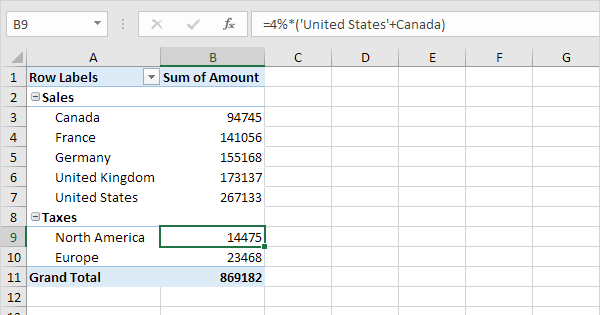
- #How to add calculated fields to pivot tables in excel 2013 how to
- #How to add calculated fields to pivot tables in excel 2013 plus
- #How to add calculated fields to pivot tables in excel 2013 download
#How to add calculated fields to pivot tables in excel 2013 how to
Watch this video to see how to create a pivot table, add a new counter field to the source data, and create a calculated field using the counter field. Video: Create Calculated Field With a Count The zipped file is in xlsx format, and does not contain macros.
#How to add calculated fields to pivot tables in excel 2013 download
To see the source data, and the Calculated Fields, you can download the sample file from my Contextures website, on the Calculated Fields – Count page. Rows with 2 orders, or fewer, show a zero (FALSE) in the CountA column. We will key in the formula in the next blank cell. Click and select the Calculated Field from the drop down menu. Calculated Field Menu in Excel 2010, Excel 2013. Here is how: Click on File on the Ribbon of an Excel workbook. To Add a Calculated Field, go to the Pivot Table Options Menu, and Find the Fields, Items & Sets drop down menu in the ribbon. But, you need to activate it before first use.
#How to add calculated fields to pivot tables in excel 2013 plus
When the Calculated Field is changed, to use the Orders field, instead of the Date, the results are correct. Excel 2013: Office Professional Plus edition of Excel 2013 includes Power Pivot. Each row will contain a 1, and those 1s can be summed, and used correctly in Calculated Fields. To fix the problem in this pivot table, I added a new field – Orders – in the source data, to act as a counter. Then, use the new field in the calculated field, and its SUM will be used, for the results that you expected.

To get correct results, you can add a new field to your source data, to act as a counter. This problem occurs because a calculated field always uses the SUM of another field, even if that field is displayed as a COUNT. The Date field is being counted in the screen shot below, and the calculated field – CountA – is checking for counts that are greater than 2.Īs you can see, all the rows show a result of 1 (TRUE) in the CountA column, even if the result is not greater than 2. For example, if you show a field that uses the COUNT function, then try to use that count in your Calculated Field, you’ll run into problems. Sometimes a Calculated Field doesn’t show the results that you expect. Below is an example of how I want my pivot table with calculated column to look. So an example would be Bob's total would be 104 instead of 73.33. You can learn the basics of Calculated Fields on my Contextures website. The formula I used was 'Stolen Bases'/ 'Attempts' but all that this did was sum the numbers. For example, add a field that multiplies the total sales by 3%, to show a Bonus amount.

The Field List has a field section where you’ll. If you dont see the Field List, try right-clicking anywhere in the PivotTable to click Show Field List. It appears when you click anywhere in the PivotTable. In addition to using fields from the source data, you can create calculated fields in a pivot table, to add your own formulas. If a workbook you’ve opened in Excel for the web has a PivotTable, you can use the Field List to add, remove, or arrange its fields.


 0 kommentar(er)
0 kommentar(er)
